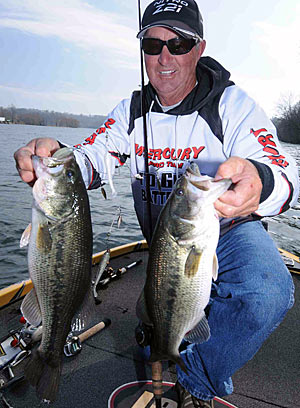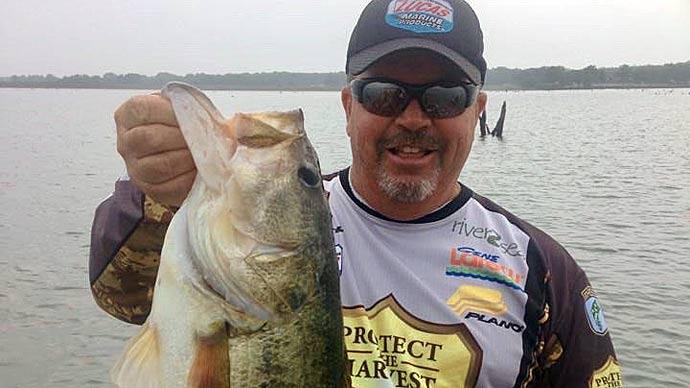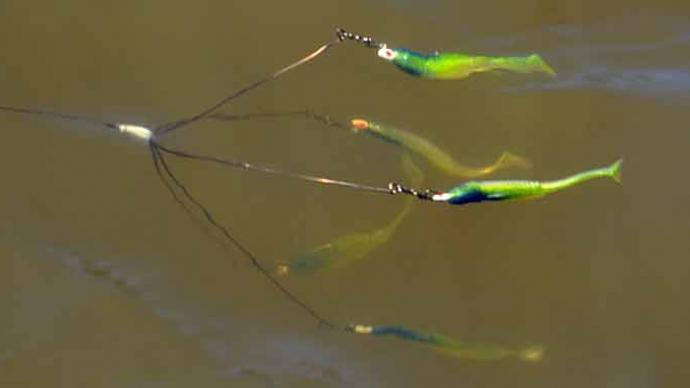
When big bass get hungry in the winter, the fish look for a super-sized meal rather than an appetizer.
The cold causes a bass’ metabolism to slow in the winter, so the fish eat less. A big bass then targets a larger meal to keep his belly full for days. So Table Rock Lake guide Pete Wenners offers heavyweight bass a buffet of baits attached to an Alabama rig.
“It catches big fish, and it is kind of a fast-moving bait for cold water,” Wenners says.
Adorned with multiple swimbaits, the Alabama rig gives the illusion of a meal that will fill a big bass’ stomach for days. “You can take a single swimbait and hardly catch anything then, but there is something about four or five baits being together like that seems to trigger those bigger fish,” Wenners says. The Missouri guide also favors the A-rig because he can fish it at various depths in the water column, unlike a suspending stickbait or a jig.
The A-rig works best for Wenners during the winter when the water temperature drops below 50 degrees. Ideal winter conditions for Wenners to throw an A-rig are a cloudy day with a slight ripple on the surface and water clarity of 3 to 5 feet.
Wenners will fish the A-rig down to depths of 35 feet, where big bass are usually lurking around standing timber on bluff ends, channel swings next to bluffs, or deep docks next to channel swings. “It is a bait at you can get down deep enough to where the fish are,” Wenners says.
His favorite A-rig is the Strike King Tour Grade Titanium Umbrella Rig, which he outfits mainly with swimbaits. “It seems like it has a lot more action when you stop and start your retrieve again,” Wenners says. “It flares out like a spinnerbait then.”
The former Bassmaster Opens competitor mixes the brands, sizes, and colors of swimbaits he attaches to his umbrella rig. “I always put my biggest bait on the center wire, usually a 4.8- or a 5-inch lure,” Wenners says. The surrounding wires of his A-rig usually feature 3.8-inch swimbaits. His favorite swimbaits for the A-rig are Strike King Rage Swimmers, Keitech Swing Impacts, and Zoom Swimmin’ Super Fluke Juniors. Wenners favors his A-rig swimbaits in chartreuse sexy shad or rainbow shad colors for fishing clear water, and if the water is stained, he sticks with the same hues but dips the lure tails in chartreuse dye.

The Missouri guide combines his swimbaits with 1/8-ounce ballhead jigs he pours. Wenners prefers this size of jighead because it allows him to fish his rig slower in deep water, and he can also fish it in shallower water by late winter when bass start moving into their prespawn stage. If he is fishing close to standing timber, Wenners will make his baits weedless by covering the jig’s hooks with Bass Pro Shops Hook Guards.
Missouri law restricts anglers to only three lures with hooks on each line, so when fishing on his home lake Wenners equips his A-rigs with three swimbaits with hooks and two “dummy” swimbaits in smaller sizes without hooks. He attaches the dummy lures with screw-lock clips to two of the rig’s top wires. Bass usually attack an A-rig from the bottom, so Wenners notices the fish miss the dummy baits that tend to ride on top of the rig. When fishing Arkansas waters such as Bull Shoals Lake, Wenners uses all five swimbaits with hooks on his A-rig, which is allowable by state law there.
A 7 1/2-foot or 7-foot, 11-inch swimbait rod is Wenners’ choice for throwing the cumbersome A-rig. He retrieves the rig with a Lew’s SuperDuty Speed Spool baitcast reel featuring a deep spool, which is needed for storing the heavy line he uses for this tactic. His line choices are either 65-pound braid line or 20- or 25-pound Suffix fluorocarbon. When fishing deeper than 30 feet, Wenners prefers the braid because he has a better feel for the rig in the deeper water. However, he favors the fluorocarbon when the weather is below freezing because the fluorocarbon wicks off the line before it enters the reel. In contrast, water remains on the braid as it enters the reel causing the spool to ice up.
After casting his rig, Wenners counts down the rig until he estimates it reaches the desired depth. “I usually just start with a slow, steady retrieve, but I like to stop and pause it like a crankbait,” Wenners says. “I think with that titanium wire, when you're reeling the rig it pulls the baits together, then when you stop reeling the titanium spreads out. Also, I think if a fish is following the rig and if you pause a lot of times, the fish will react and bite it.”
Watching his Garmin Panoptix electronics allows Wenners to see any bass following the A-rig. “If I see a fish coming up and following it, but I am not getting a strike, then sometimes I will even speed up my retrieve as I would with a big spoon or a crankbait,” he says. “Then I will stop it for a second and speed it up again.”
Wenners describes a strike on the A-rig is similar to what he feels when fishing a single swimbait. “Sometimes the fish will hit it two or three times before they load up,” Wenners says.
The A-rig has produced some big bites for Wenners in recent winters. He has caught two bass over 9 pounds from Table Rock on the rig and weighed in an 8-06 fish in a winter tournament.
BassResource may receive a portion of revenues if you make a purchase using a link above.




